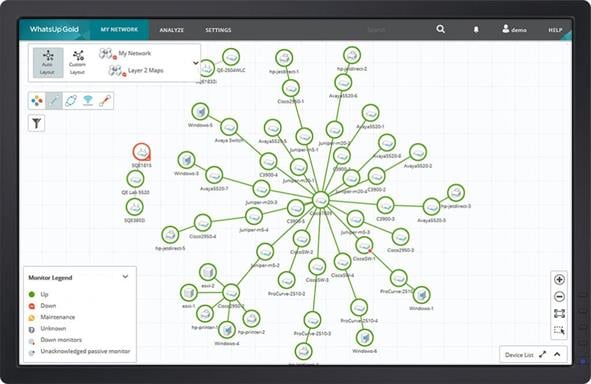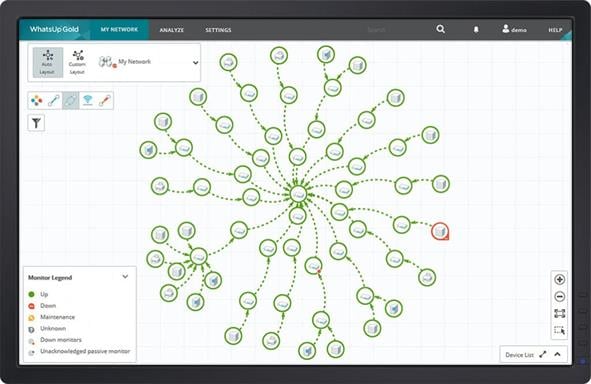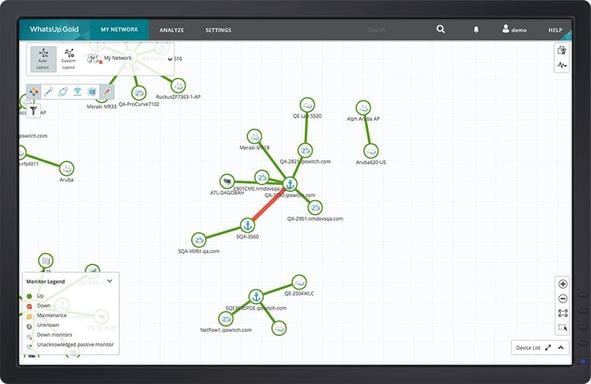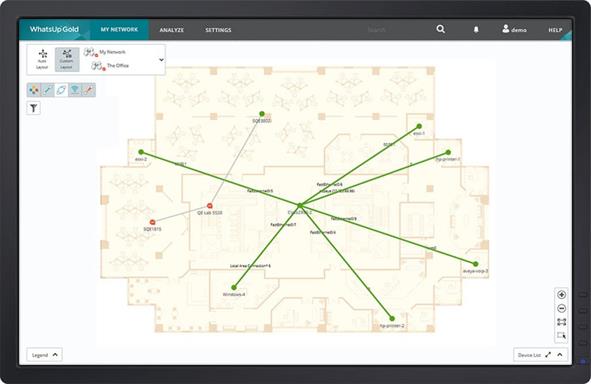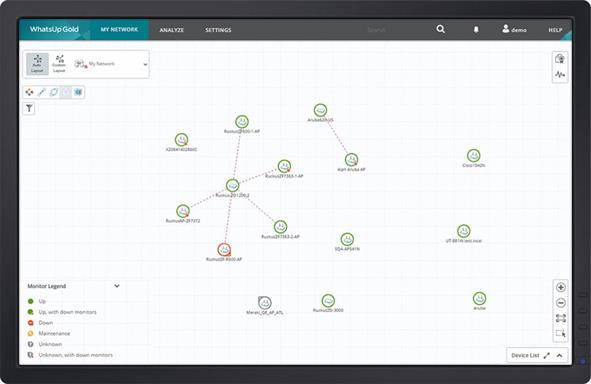
Network Mapping Tools & Software
Use WhatsUp Gold's network mapper to inventory, map and visualize network topology.
The Most Comprehensive Network Mapping Solution
WhatsUp Gold provides you with an intelligent network mapping tool that combines Layer 2 and Layer 3 detection methods to create comprehensive, interactive network maps that are easily customizable. The network mapping software discovers and collects information from any network asset using Layer 2/3 discovery techniques, including SNMP, ARP, ICMP, Virtual Infrastructure Management, IP addressing, CDP, LLDP, etc. WhatsUp Gold then creates dynamic layer 2 maps giving administrators a comprehensive view of their entire infrastructure.
Discover and map everything connected to your network
Auto-generate interactive Layer 2 and 3 topology network maps
Dynamically update maps as changes occur on your network
Detect and visualize device dependencies
Customize your maps with images, text and links
Automated Discovery and Network Mapping
WhatsUp Gold's real-time network mapping tool uses a number of innovative Layer 2/3 discovery technologies — including ARP, SNMP, SSH, Virtual Infrastructure Management, IP addressing, ICMP and LLDP in combination with vendor-proprietary mechanisms — to discover everything connected to your network and build a complete and accurate picture of network devices and their port-to-port connectivity. By correlating Layer 3 discoveries with Layer 2 details, WhatsUp Gold offers a complete and granular view of your network.
Detect and Map Device Dependencies
WhatsUp Gold detects downstream dependencies that allow alarm suppression. For instance, if a router fails then devices downstream from the router (from the perspective of the ping or poll device) will register as unavailable on the monitoring screen and will trigger alerts. Such scenarios can result in confusing alert storms and delay the fault isolation process. WhatsUp Gold automatically detects such dependencies thereby suppressing downstream alerts.
Interface Utilization & Traffic Analysis
WhatsUp Gold monitors bandwidth usage and provides a visual representation or ‘heat map’ of the status of links between your devices. With one click you can see which interface links are fine (green), becoming congested (yellow) or approaching capacity (red). These thresholds are customizable and you can trigger alerts if any links exceed a set threshold. This overlay lets you see network congestion at a glance and helps you not only optimize network bandwidth usage, but also architect your network effectively.
Customize Your Network Maps
The default map in WhatsUp Gold shows the live status of your devices and automatically arranges them based on role and connectivity information gathered during the discovery process. You can tailor custom maps to meet your specific network monitoring needs with tools to organize, annotate, and enhance your network map. You can even add your own background images to create custom maps of your office or organize subnets into logical groups.
Map Wireless and Virtual Environments
Discover and map your wireless network, virtual and cloud-based servers to quickly assess the health of your entire infrastructure. WhatsUp Gold's network mapper automatically generates dynamic wireless maps of all WLCs, Access Points and SSIDs. Enabling the wireless overlay allows you to see the relationship between your wired and wireless networks. Virtualization overlays automatically generate dynamic maps of your Hyper-V and VMware infrastructure, displaying hosts and guests, host/guest relationships, clusters, and real-time status.

Dynamic Network Maps
With networks growing at exponential speeds, your network management software must be able to automate resource discovery and mapping. A dynamic map is especially useful in virtual environments, where virtual machines can be added with ease. Integrated map-based configuration management and troubleshooting tools are additional pluses.
WhatsUp Gold automatically discovers and maps new devices, port-to-port connectivity changes, or updates to physical-to-virtual associations without end user intervention. You can also schedule network scans to update your maps at pre-configured intervals.
Get Started
Complete the form to Try WhatsUp Gold' network mapping tool for free!
Frequently Asked Questions
What is network mapping?
Network mapping is the process of discovering the devices connected to a network and how they are interconnected. In the strictest sense, network mapping is purely the portrayal of interconnectivity and should not be confused with network discovery which delves into the physical characteristics of network devices.
How does network mapping work?
Network mapping starts with discovery. Layer 3 discovery locates and identifies devices. Layer 2 discovery detects interconnecting links, port-to-port connectivity and VLAN information. Together they discover the devices on your network and how they are connected. The devices and their connectivity are visually represented as a network map.
What is the difference between Layer 2 and Layer 3 network mapping?
Layer 2 and Layer 3 network mapping refer to different levels of network topology discovery and visualization:
- Layer 2 Mapping: This focuses on the physical and data link layer connections between devices, such as switches, access points, and endpoints. It identifies how devices are physically connected within the network, typically using protocols like LLDP (Link Layer Discovery Protocol) and SNMP (Simple Network Management Protocol).
- Layer 3 Mapping: This operates at the network layer, focusing on the logical IP-based connections between devices, such as routers and subnet relationships. Layer 3 mapping provides visibility into how data travels across the network, often leveraging routing tables and ARP (Address Resolution Protocol) data.
WhatsUp Gold supports both Layer 2 and Layer 3 mapping, allowing users to visualize their network infrastructure from both a physical and logical perspective.
How can a network mapper help with troubleshooting?
A network mapper helps troubleshoot by providing real-time visibility into device status, connections, and network paths. With tools like WhatsUp Gold, users can quickly identify connectivity issues, detect unauthorized devices, monitor performance metrics, and simplify root cause analysis. This reduces downtime and improves overall network performance.
What are the best features to look for in a network mapping tool?
A good network mapping tool should include automated discovery to identify devices, real-time monitoring to track performance, and both Layer 2 and Layer 3 mapping for a complete view of the network. It should also offer troubleshooting tools to quickly detect and resolve issues.
What is Network Topology Map?
A topology map is one of the most commonly used network management tools.
Learn More about Network Topology MapWhat is Network Diagram?
A network diagram is essential for visualizing network design and network relativity.
Learn More about Network DiagramWhat is Network Assets?
Network assets can vary from hardware (routers, printers and servers) to software assets (OS, applications and updates).
Learn More about Network AssetsWhat is VLAN Management?
With their logical partitioning and grouping capabilities, VLANs are an integral part of networks.
Learn More about VLAN Management